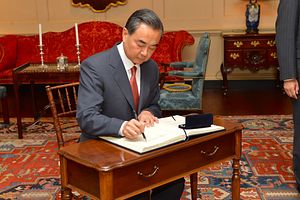China’s foreign minister said on Wednesday that he expects November’s APEC summit to take up the issue of creating an Asia-Pacific Free Trade Area (also known as a Free Trade Area of the Asia-Pacific, or FTAAP). FTAAP would mesh with China’s strategy of promoting regional integration – and would provide an alternative to the U.S.-led Trans-Pacific Partnership (TPP) talks, which currently excludes China.
Foreign Minister Wang Yi made his remarks at the Lanting Forum, which was billed by China’s Foreign Ministry as “a preview of the theme, agenda, and outcomes of the 22th APEC Economics Leaders’ Meeting.” According to Xinhua, Wang said that this November’s APEC summit will see progress on an Asia-Pacific Free Trade Area. Wang hopes that APEC members will send a “clear message” on regional economic integration by advancing the FTAAP.
According to China’s vision, this massive FTA would effectively overrule the piecemeal free trade agreements that currently exist (or are under negotiation) among Asia-Pacific economies. The FTAAP “will help to integrate regional bilateral and multilateral cooperation mechanisms and reduce the risk of overlap and fragmentation,” Xinhua paraphrased Wang as saying. Back in May, when a Chinese Ministry of Commerce official urged “quick action” on an Asia-Pacific FTA, he argued that this larger FTA “will solve the problems caused by barriers between different FTAs, such as distinct rules and requirements.”
The FTAAP would thus provide an attractive alternative to the TPP, which is its current form would exclude China, the region’s largest economy. Given the current stalemate over TPP negotiations (something my colleague Clint covered in more detail over on the Tokyo Report), Beijing may be sensing an opportunity to forestall TPP by pushing forward with a larger, more integrated vision for regional trade.
Some in APEC, meanwhile, are taking the opposite viewpoint, wondering if FTAAP is necessary given the multitude of other trade deals already under discussion. According to the South China Morning Post, APEC secretariat executive director Alan Bollard said that it might be too complicated to work on FTAAP alongside all the other trade negotiations already in progress. “None of the economies want to start negotiating on the FTAAP. It is far too early to do that,” Bollard said.
The idea for FTAAP has been around for nearly a decade – for example, in 2006, C. Fred Bergsten of the Peterson Institute for International Economic argued that an Asia-Pacific FTA “is the next step forward for APEC.” Despite this, there’s been little progress to date as countries has pursued smaller multilateral or simply bilateral agreements. Bollard’s hesitancy indicates China faces an uphill battle to overcome this inertia.
Still, China is pushing forward with the idea. SCMP reports that China is calling for a feasibility study on the FTAAP, which is generally the first formal step in crafting an FTA. Bollard downplayed expectations, saying that “we have not yet agreed on the study … We are not at all clear about what it means.”
From Beijing’s perspective, the FTAAP means an interconnected Asia-Pacific region – with China, as the region’s (and soon to be the world’s) largest economy, naturally at the center. China’s other high-profile plans for economic integration, the Silk Road Economic Belt and the Maritime Silk Road, echo the idea that the region’s economies should be more integrated. Both those initiatives also focus on literal connectivity – transportation and infrastructure to connect Asia-Pacific states. China also intends to emphasize this at APEC by pushing for a “blueprint” for interconnectivity in the Asia-Pacific in both transportation (highways, railways, air traffic) and regulations.
By taking the leading role in pushing for economic integration and interconnectivity, China can also position itself as the leader of this as yet hypothetical Asian community. In his remarks Wednesday, Wang Yi emphasized that China and the Asia-Pacific are part of a “community of shared destiny,” repeating Beijing’s favorite way of conceptualizing the region.
Under this concept, China stresses that its success is the main driver for regional success. China has contributed more than 50 percent of economic growth in Asia,” Wang pointed out, noting that each percentage point of economic growth in China lifts the economy of the region by 0.3 percent. Wang also stressed that “China has been working on playing a constructive role in regional affairs.” As “a member of the Asia-Pacific family,” Wang said, China accepts the responsibility to promote regional prosperity and stability.
Last year, China Power blogger Jin Kai noted that this formulation was China’s response to the U.S. “rebalance to Asia.” Through its various initiatives, from economic proposals like the Silk Road Economic Belt to FTAPP, to political groupings like the Shanghai Cooperation Organization and the Conference on Interaction and Confidence-Building Measures in Asia (CICA), China is attempting to establish its leadership bona fides in the Asia-Pacific region. Once China is established as a regional leader, both economically and politically, there will be no further need for the U.S. in the region — or so Beijing hopes.

































